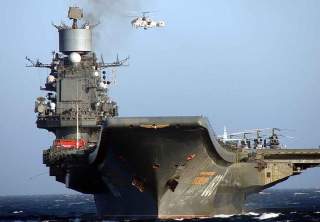Is Russia’s Only Aircraft Carrier Doomed?
Russia’s sole aircraft carrier is on fire. The blaze aboard Admiral Kuznetsov could mean the end of Russian at-sea, fixed-wing naval aviation.
Russia’s sole aircraft carrier is on fire. The blaze aboard Admiral Kuznetsov could mean the end of Russian at-sea, fixed-wing naval aviation.
The fire started at 10:20 in the morning, local time on Dec. 12, 2019, when diesel fuel ignited on a lower deck, Russian media reported. Kuzentsov at the time was pierside in Murmansk for pre-planned repairs following a disastrous 2016 deployment to the Syrian coast.
The blaze spread to cover 6,500 square feet as firefighters struggled to contain it. One person died and 10 were injured in the fire, TASS reported. Six are in intensive care.
The fire is the latest in a series of mishaps to afflict the 60,000-ton-displacement flattop. The Russian navy had planned to dry-dock Kuznetsov in 2020 and conduct extensive repairs on the aging, unreliable vessel. The fire could weigh on that plan.
Kuznetsov commissioned in 1990. Problems plagued the ship from the beginning. One of the carrier’s major weaknesses is her lack of catapults for launching her fighters. Another is her powerplant. The vessel is powered by steam turbines and turbo-pressurized boilers that Defense Industry Daily generously described as “defective.”
Her pipes are bad. “When it’s this cold, water freezes everywhere including pipes which may cause a rupture,” English Russia reported. “To prevent this, they just don’t supply almost 60 percent of the cabins with water (neither in winter nor in summer). The situation with latrines is just as bad. The ship has over 50 latrines [for 1,900 crew] but half of them are closed.”
Kuznetsov rarely goes to sea and conducted just six patrols between 1991 and 2015. During a 2016 mission off of Syria, the ship’s air wing lost two jets in just three weeks.
Before late 2018, Moscow planned on extending the service lives of Kuznetsov and other warships from the 1980s in order to complement the newer, smaller vessels.
But Kuznetsov in October 2018 suffered serious damage at the 82nd Repair Shipyard in Roslyakovo, a northern port city, when the PD-50 dry-dock sank while the carrier was aboard for repairs.
Swedish-built PD-50 was the only large dry-dock capable of supporting the Russian northern fleet’s largest warships. Russia's other large dry-docks are thousands of miles from the fleet's main northern bases.
Moving the docks, or the ships needing repair, could be prohibitively difficult, expensive and time-consuming. Beside the cost, foreign sanctions complicate the acquisition of a dock similar to PD-50.
According to the newspaper Izvestia, the Kremlin considered just decommissioning Kuznetsov rather than spending the money to acquire a new dry-dock, move an existing dock or the carrier or find some other way of repairing the aging, unreliable and accident-prone flattop.
“Not everyone considers the continuation of repair to be appropriate,” a navy source reportedly told Izvestia. “There are different opinions, including those that boil down to the fact that with this money it is better to build a pair of frigates or a nuclear submarine.”
By spring 2019 a plan reportedly was in place to assemble a new dry-dock that in theory could accommodate the carrier, Moss and Vest explained. The No. 35 Ship Repair Plant in Murmansk in northern Russia has two, adjacent 200-meter-long dry-docks that yard workers could combine in order to fit Kuznetsov.
“However, the modifications may not be as easy as the source would have us believe,” Moss and Vest wrote. “Even after the two dry-docks are combined, they will have to be lengthened to accommodate the 305-meter ... aircraft carrier, and a new gate structure of the combined dock will have to be custom fabricated.”
The current fire further complicates the repair plan. Now Kremling planners must weigh Kuznetsov’s value as a symbol of national prestige against her poor condition and the safety risk she poses to workers and crew.
What indisputable is the flattop’s declining value as an operational asset, naval experts Richard Moss and Ryan Vest explained in Proceedings, the professional journal of the U.S. Naval Institute. “From the perspective of utility to current Russian navy strategy, ‘Kuzya’ is a huge resource sump that will never offer as much value as several Yasen-class fast attack submarines or a squadron of small, lethal missile patrol boats.”
“She has never performed her original mission of extending Russia’s defensive perimeter, nor has she been a reliable power-projection platform,” Moss and Vest continued. “The ship has suffered her share of powerplant, hull, aircraft launch and recovery, electrical and mechanical problems and is expensive to man and maintain.”
It was doubtful even before the fire that the Russian navy could repair Kuznetsov on time. “Considering the necessary dry-dock modifications, the current fiscal realities the Russian government is facing under sanctions and lower oil prices and endemic corruption, the Kuznetsov may be undergoing modernization for the foreseeable future,” Moss and Vest explained.
Now that the ship is burning, it’s less likely she will return to service any time soon. Or ever.
David Axe serves as Defense Editor of the National Interest. He is the author of the graphic novels War Fix, War Is Boring and Machete Squad.

